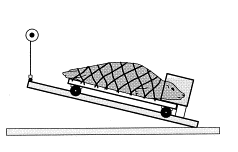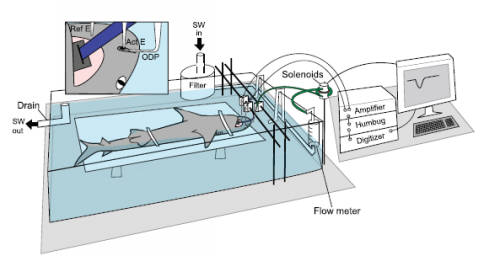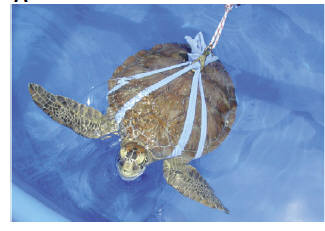 The stereotype of a scientific diagram is a complex, dry, boring graph. While many earn this reputation, a few make can make people do a double-take. Most of these explain research methods involving live animal test subjects. A few of my favorites are shown below.
The stereotype of a scientific diagram is a complex, dry, boring graph. While many earn this reputation, a few make can make people do a double-take. Most of these explain research methods involving live animal test subjects. A few of my favorites are shown below.
It is important to note that these images do not show animal abuse of any kind. All of the experimental procedures shown below were approved by Institutional Animal Care and Use Committees because they are the best way to answer important questions about these animals. They were carried out by highly respected professional scientists, and some led to breakthroughs that change how we think about the natural world. They also happen to be quite funny if you view them out of context.
1) Waterboarding a seal?
The diagram:

Why the heck would anyone do that?
Many marine mammals, including seals, are able to dive to incredible depths. Some can regularly reach hundreds (or even thousands) of meters below the surface on a single breath of air. The record for humans is a little over 200 meters, but most people have trouble touching the bottom of the deep end at their local swimming people. Scientists wanted to learn how animals like seals are able to accomplish this incredible physiological feat. By simulating immersion in water by face-dunking, they were able to study what happens to seals when they dive without leaving the comfort of your own lab.
2) Franken-Shark
The diagram:

Why the heck would anyone do that?
The shark’s sense of smell is legendary among the general public, but it is relatively poorly understood by scientists. One of the established methods for quantifying olfactory thresholds is to expose an animal to differing concentrations of chemicals and measure whether or not the brain of that animal reacts. Doing this requires attaching electrodes to the animal, and that requires that the animal be restrained.
3) Going nowhere fast
The diagram:


Why the heck would anyone do that?
As soon as they hatch, baby sea turtles run towards the ocean. Decades later, they return to the same beach where they were born. In the meantime, they swim across oceans to different “developmental habitats”. Scientists wanted to understand how they navigate. It’s not practical to follow a small animal for thousands of miles in the wild, they don’t make tanks large enough to simulate ocean basins, and an unrestrained turtle in a small tank would be constantly bumping into the tank walls. The above diagram is a clever solution to this dilemma. Restraining the turtle in the water column allows it to swim freely without ever really going anywhere. Scientists could then modify things like the lights and magnetic fields outside the tank, allowing them to test what cues turtles use to orient themselves.
4) Obstacle course… of doom?
The diagram:

Why the heck would anyone do that?
The long-distance migrations of birds have fascinated laymen and scientists alike throughout human history. Many hypothesized that birds had the ability to detect the Earth’s magnetic field, and that this ability was used in long-distance navigation. The chamber above tests that hypothesis by exposing a homing pigeon to magnetic fields.
5) Shrimp…on a treadmill?
The diagram (okay, it’s a YouTube video, but it shows the methods clearly).
For this research, shrimp were placed on a treadmill. In case you are wondering, the music was edited in after the fact.
Why the heck would anyone do that?
The shrimp on a treadmill research is near and dear to my heart because it was performed by my physiology professor, Dr. Lou Burnett, who is the director of the College of Charleston’s marine laboratory. Goofy music aside, the research is actually very important. He is running stress tests, just like human doctors occasionally do to us, on shrimp to see how they react to the low-oxygen conditions that being found all around the world with alarming frequency. The video above has over one million hits, which might make it the most-viewed marine biology research of all time. Spinoffs featuring music like “Eye of the Tiger” and “Chariots of Fire” are also quite popular, and this viral video led to Dr. Burnett appearing on the Today show.
Closing thoughts: Public perceptions of science and scientists are inaccurate to say the least. Science isn’t all microscopes and number-crunching. Lots of important research involves manipulating the natural world in ways that the general public would find amusing or even fascinating. Humor seems to me like a great way to change things.
Hochachka, P. (2000). Pinniped diving response mechanism and evolution: a window on the paradigm of comparative biochemistry and physiology Comparative Biochemistry and Physiology – Part A: Molecular & Integrative Physiology, 126 (4), 435-458 DOI: 10.1016/S1095-6433(00)00231-2
Lohmann, K., Lohmann, C., & Putman, N. (2007). Magnetic maps in animals: nature’s GPS Journal of Experimental Biology, 210 (21), 3697-3705 DOI: 10.1242/jeb.001313
Meredith TL, & Kajiura SM (2010). Olfactory morphology and physiology of elasmobranchs. The Journal of experimental biology, 213 (Pt 20), 3449-56 PMID: 20889825
Mora, C., Davison, M., Martin Wild, J., & Walker, M. (2004). Magnetoreception and its trigeminal mediation in the homing pigeon Nature, 432 (7016), 508-511 DOI: 10.1038/nature03077
SALMON, M., & WYNEKEN, J. (1987). Orientation and swimming behavior of hatchling loggerhead turtles Caretta caretta L. during their offshore migration Journal of Experimental Marine Biology and Ecology, 109 (2), 137-153 DOI: 10.1016/0022-0981(87)90012-8
I feel obliged to mention Figure 1 Wear. Moose is always on the lookout for a good new one.
These are great. The shrimp on a treadmill made my day.
Please make this a recurring series.
I was planning on it, but thanks for the encouragement!
Sweet! I’ve never heard of that before.
I’m sad to learn that the music in the shrimp video was added later. I think that it should be required to allow future shrimp to exercise to TV theme music.
I think the somewhat comical illustrations convey a light hearted sense to the public, perhaps sparking an interest in the models they are depicting.